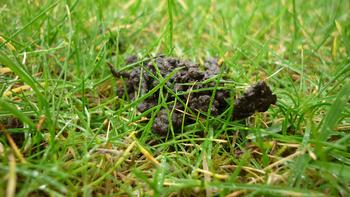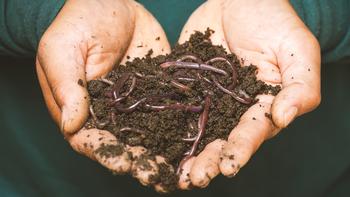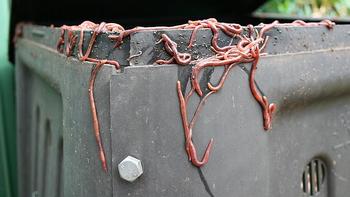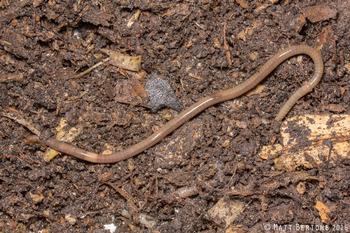Earth movers
-
Barbara Robertson
-
You might not have thought much about earthworms. If so, it may surprise you to learn that Charles Darwin studied earthworms for 40 years, earthworms are causing a climate change controversy, there is a Northern California native earthworm, and that you can help prevent the spread of an invasive earthworm pest.
 Darwin observed earthworm-created humus covering stones in his garden at the rate of 2.2 inches in 10 years. Photo: Kris Lord
Darwin observed earthworm-created humus covering stones in his garden at the rate of 2.2 inches in 10 years. Photo: Kris Lord“It may be doubted whether there are many other animals which have played so important a part in the history of the world, as have these lowly organized creatures,” wrote Darwin in his last book, “The Formation of Vegetable Mould [humus] through the Action of Worms, with Observations of their Habits.”
It’s easy to think of earthworms’ simple roles. They give early birds a reason to rise, fish to avoid a hook, and they mess about underground. In the garden, some live near the surface under leaves and duff (decaying organic matter); some stay mostly below to burrow through the soil, aerating and improving soil fertility along the way; others move back and forth. All the while, earthworms swallow soil, eat organic matter, and produce rich humus via their poop or, more politely, worm casts. Most earthworms deposit castings on the surface.
And these deposits add up. Darwin observed near his house and in some other locations that earthworms produced .22 inches of humus per year. He concluded that many ancient objects and building remains in England had been largely buried and preserved through the action of worms. A handful of worms & castings. The humus is richer in nutrients than the sources ingested by the earthworms to produce it. Photo: sippakorn-yamkasikor
A handful of worms & castings. The humus is richer in nutrients than the sources ingested by the earthworms to produce it. Photo: sippakorn-yamkasikorThis earth-moving characteristic is ringing alarm bells among some scientists studying climate change. Soil that is not tilled can sequester carbon; tilling releases greenhouse gases. And earthworms are natural and unstoppable tillers. One study says yes, they cause carbon dioxide emissions. Another says they regulate ecosystem functions and thus reduce emissions. More studies are needed.
For their part, Darwin and his sons discovered that earthworms couldn’t see, but they could distinguish between light and dark. Earthworms don’t hear but are extremely sensitive to vibration. They seize leaves and other objects, even stones, to serve as food or to plug up their burrows. And the Darwins discovered they move these objects cleverly.
Their experiments showed that earthworms choose whether to draw a leaf into a burrow by its tip, middle, or stem; so, too, with pine needles. Darwin writes, “If we consider these cases, we can hardly escape from the conclusion that worms show some degree of intelligence in their manner of plugging up their burrows.”
Intelligence aside, nearly all earthworms enhance soil fertility. Native earthworms, however, might have the greatest overall effect because they tend to be active longer on the soil surface. Eisenia fetida “Red Wiggler” worms inside a worm bin turn food scraps into compost. Photo: Tony Hudson
Eisenia fetida “Red Wiggler” worms inside a worm bin turn food scraps into compost. Photo: Tony HudsonUnfortunately, only one native, the Argilophilus, has been found in Northern California, and its population is decreasing as its habitat shrinks. A white worm with blue markings, it prefers undisturbed soil. Thus, most earthworms we see, including red wigglers used as bait, and those sold for vermicomposting worm bins, are invasive species. Invasives do better in human-disturbed environments.
One invader from Asia, the Amynthas agrestis, or “jumping worm,” is doing too well and potentially causing harm. The A-rated pest devours leaf litter and duff and thus threatens native plants in forests that depend on this organic matter.
Earthworms don’t travel far on their own. So, don’t move this one. Don't buy or use jumping worms for fishing bait, in worm bins, or in your garden. Check your hiking boots, new mulch, compost, and potting soil in new plants. A jumping worm pest on its coffee-ground like castings, with white band near its head. If seen, contact the UC MMG help desk. Photo: M. Bertone, NCSU
A jumping worm pest on its coffee-ground like castings, with white band near its head. If seen, contact the UC MMG help desk. Photo: M. Bertone, NCSUJumping worms are four to five inches long, dark gray or brown, with a milky-white band wrapping the body near the head. And, they do indeed jump, even propel themselves off the ground and thrash when disturbed.
One has been spotted in Napa. Look under pots, on landscape fabric, and under leaf litter in forests. If you discover jumping worms, contact the Marin Master Gardeners’ help desk. And find out more about earthworms on our website: https://marinmg.ucanr.edu.




